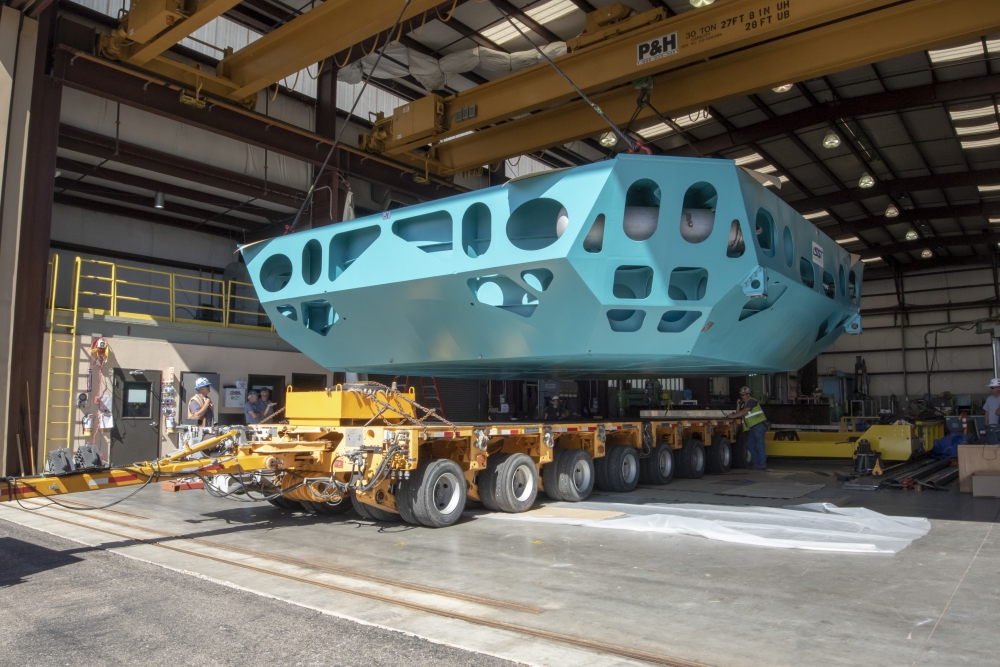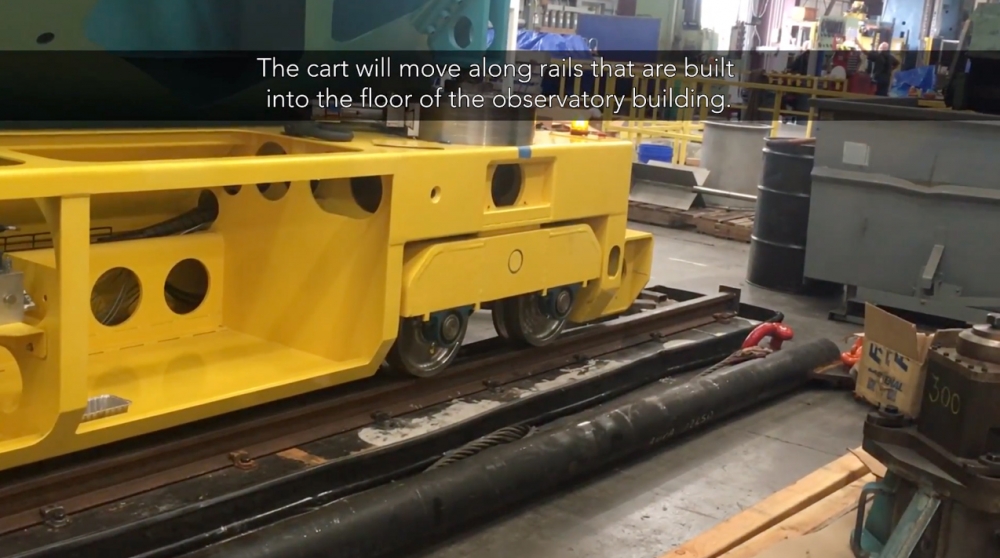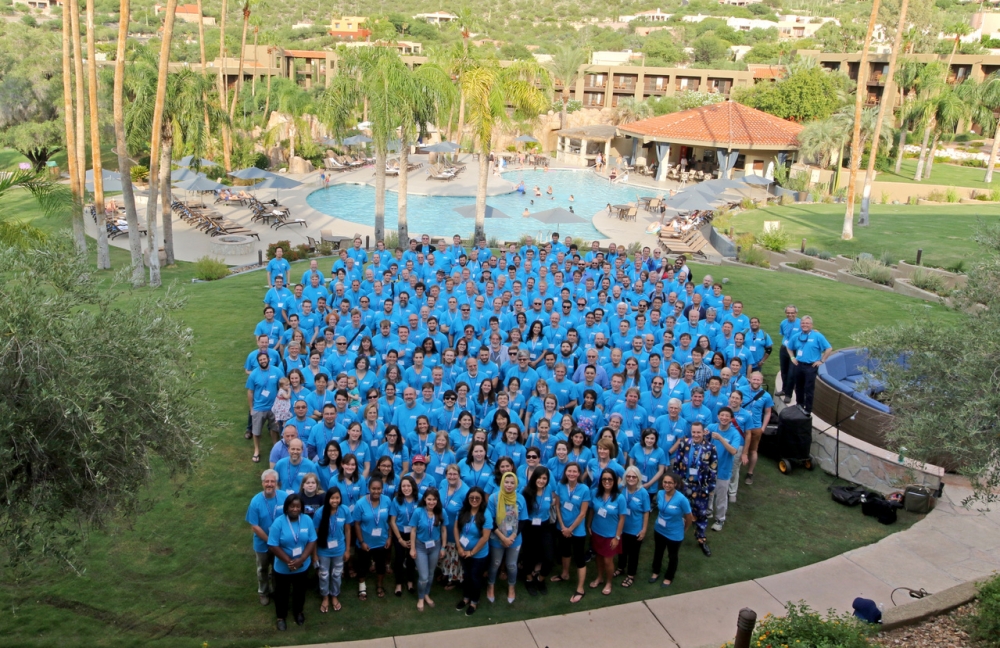The LSST Project Office is delighted to announce that Professor Zeljko Ivezic of the University of Washington has agreed to take on the role of Deputy Director of the LSST Construction Project, effective September 1, 2018. Read the announcement from Steve Kahn here.
LSST Senior Management staff recently participated in a productive quarterly meeting of AURA’s Management Council for LSST (AMCL), which took place September 5-6 at SLAC National Accelerator Laboratory in California. Agenda items included an introduction of new members of the Council, and a discussion of the results of the recent NSF/DOE Joint Status Review for LSST.
The Call for White Papers on LSST Cadence Optimization is still open; provide your input on LSST observing strategy by submitting before the November 30, 2018 deadline. Click here for more information.
New photos of the LSST cryostat assembly, completed at SLAC in late June, are now available at this link. The cryostat will keep the LSST Camera’s image sensors continuously cooled to -150 degrees Fahrenheit for crisp, high-sensitivity views of the night skies during operations.
On September 7, the LSST Coating Chamber was loaded on the BBC Arizona in Antwerp, Belgium. The ship departed that evening, and is expected to arrive in Coquimbo, Chile in late October. A photo of the Coating Chamber being loaded is available in the LSST Gallery. You can also track the ship’s progress at this link.
An LSST Telescope and Site team recently traveled to Rochester, NY to witness final verifications and conduct final inspections of the Secondary Mirror (M2) Cell Assembly. Now that final acceptance is complete, the M2 Cell Assembly will soon travel by truck to the port of Albany, NY, and from there by ship to Chile.
A new video of the TMA taken weeks prior to the official start of Factory Acceptance Testing is available in the LSST Gallery. During the next month, a team of LSST engineering support staff members will travel to Spain to review the TMA’s pointing and control performance, mechanical and electrical systems, computer and camera refrigeration interfaces, and camera access. LSST Systems engineering personnel will also be onsite towards the end of October to collaborate with the Contractor in conducting final tests and to determine the readiness of the TMA for its voyage to Chile.
A Day In The Life (DITL) of LSST construction is coming up! We’ve selected Thursday, October 4, 2018, as the day when everyone working on LSST is encouraged to take a picture of something interesting and representative of their work to chronicle the LSST construction. See here for more info and here for previous years’ DITL video.
LSST CORPORATION NEWS
The LSST Cadence Hackathon, hosted by LSST Corp and the Simons Center for Computational Astrophysics, took place at the Flatiron institute Sept 17-19. At the Hackathon, participants from different LSST Science Collaborations worked together in teams to explore creative cadence strategies in order to maximize the scientific output of LSST for all eight Science Collaborations.
PERSONNEL NEWS
CC-IN2P3 is hiring a Scientific Data Processing Engineer, based in Lyon, France, to join the team in charge of the processing of LSST data. This full-time position is available immediately and is initially of a limited duration of 12 months, renewable. More information is available at this link.
Gabor Kovacs joined the Data Management Subsystem as a Science Pipelines Developer on September 4. Gabor will work with the Alert Production team, developing algorithms for image differencing and other Science Pipelines capabilities.
UPCOMING MEETINGS with LSST INVOLVEMENT
(those with asterisk* are LSSTC funded):
2018 | |
September 27-28 | LSST Corporation Executive Board Retreat, Tucson, AZ* |
October 21-26 | AAS Division of Planetary Sciences (DPS) 50th Annual Meeting, Knoxville, TN |
October 22-26 | LSST-DESC Autumn Sprint Week, Edinburgh, Scotland* |
October 24-25 | LSST Corporation Institutional & Executive Board Meeting, Tucson, AZ* |
November 11-15 | 28th Annual Astronomical Data Analysis Software and Systems (ADASS) Meeting, College Park, MD |
November 12-15 | Supercomputing 2018, Dallas, TX |
December 17-21 | South American Workshop on Cosmology in the LSST Era, Sao Paulo, Brazil |
2019 | |
January 6-10 | AAS 233rd Meeting, Seattle, WA |
May 20-23 | LSST@Asia, Sydney, Australia* |
NOTICIAS DEL PROYECTO & CIENTIFICAS
La Oficina de Proyectos de LSST se complace en anunciar que el Profesor Zeljko Ivezic de la Universidad de Washington aceptó en asumir el cargo de Subdirector del Proyecto de Construcción LSST, a partir del 1 de septiembre del 2018. Lea el anuncio de Steve Kahn aquí.
El personal de Administracion Senior de LSST participó recientemente en una productiva reunión trimestral del Consejo de Administración AURA para LSST (AMCL), que tuvo lugar del 5 al 6 de septiembre en el Laboratorio de Aceleración Nacional SLAC en California. Los puntos de la agenda incluyeron una introducción de los nuevos miembros del Consejo y una discusión de los resultados de la reciente NSF/DOE Joint Status Review para LSST.
La Convocatoria de Propuestas sobre la Optimatizacion de Cadencia LSST aun está abierta; proporcione su opinión sobre la estrategia de observación de LSST presentandola antes del 30 de noviembre del 2018 fecha límite. Haga clic aquí para más información.
Nuevas fotos del montaje del criostato LSST, realizado en SLAC a fines de junio, ahora están disponibles en este enlace. El criostato mantendrá los sensores de imagenes de la cámara LSST continuamente refrigerados a -150 grados Fahrenheit para obtener vistas nítidas y de alta sensibilidad de los cielos nocturnos durante las operaciones.
El 7 de septiembre, la Cámara de Recubrimiento LSST fue cargada en el BBC Arizona en Antwerp, Bélgica. El barco partió esa tarde y se espera que llegue a Coquimbo, Chile a fines de Octubre. Una foto de la Cámara de Recubrimiento que se está cargando está disponible en la Galería LSST. También puedes rastrear el progreso del barco en este enlace.
Un equipo de Telescope&Site recientemente viajó a Rochester, NY para presenciar las verificaciones finales y realizar las ultimas inspecciones del Montaje de la Celda del Espejo Secundario (M2). Ahora que se ha completado la aceptación final, el Montaje de la Celda M2 viajará pronto en camión al puerto de Albany, Nueva York, y desde allí en barco a Chile.
Un nuevo video del TMA tomada semanas antes del inicio oficial de la Prueba de Aceptación de Fábrica está disponible en la Galería LSST. Durante el próximo mes, personal de soporte de Ingeniería de LSST viajará a España para revisar el TMA’s pointing and control performance, los sistemas mecánicos y eléctricos, las interfaces de refrigeración de computadoras y cámaras, y el acceso a la cámara. El personal de Ingeniería de Sistemas de LSST también estará presente a finales de Octubre para colaborar con el contratista en la realización de las pruebas finales y determinar la preparación del TMA para su viaje a Chile.
¡Se esta acercando Un Día En La Vida (DITL) de la construcción de LSST! Seleccionamos el Jueves 4 de Octubre del 2018 como el día en que se anima a todos los que trabajan en LSST a tomar una foto de algo interesante y representativo de su trabajo para hacer una crónica de la construcción de LSST. Ver aquí para más información y aquí para el video DITL de años anteriores.
NOTICIAS CORPORATIVAS DE LSST
El LSST Cadence Hackathon, organizado por la Corporacion LSST y el Centro para la Astrofísica Computacional Simons, se llevó a cabo en el instituto Flatiron del 17 al 19 de septiembre. En el Hackathon, los participantes de diferentes colaboraciones científicas de LSST trabajaron juntos en equipos para explorar estrategias de cadencia creativa con el fin de maximizar la producción científica de LSST para las ocho Colaboraciones Científicas.
NOTICIAS DEL PERSONAL
CC-IN2P3 está contratando a un Ingeniero de Procesamiento de Datos Científicos, con sede en Lyon, Francia, para unirse al equipo a cargo del procesamiento de datos de LSST. Este puesto de tiempo completo esta disponible de forma inmediata y tiene inicialmente una duración limitada de 12 meses, renovable. Más información está disponible en este enlace.
Gabor Kovacs se unió al Subsistema de Gestión de Datos como Desarrollador Cientifico de Pipelines el 4 de Septiembre. Gabor trabajará con el equipo de Produccion de Alertas, desarrollando algoritmos para la diferenciación de imágenes y otras capacidades de Ciencia Pipelines.
PRÓXIMAS REUNIONES con LA PARTICIPACIÓN DE LSST
(aquellas con asterisco * son financiados por LSSTC):
2018 | |
Septiembre 27-28 | Retiro de la Junta Corporativa Ejecutiva de LSST, Tucson, AZ* |
Octubre 21-26 | División AAS de Ciencias Planetarias (DPS) Reunion Anual 50, Knoxville, TN |
Octubre 22-26 | LSST-DESC Autumn Sprint Week, Edinburgh, Escocia* |
Octubre 24-25 | LSST Corporation Institutional & Executive Board Meeting, Tucson, AZ* |
Noviembre 11-15 | Reunión Anual de Software y Sistemas de Análisis Astronómico de Datos 28ª (ADASS) |
Noviembre 12-15 | Supercomputing 2018, Dallas, TX |
Diciembre 17-21 | Taller Sudamericano sobre cosmología en la era LSST, Sao Paulo, Brasil |
2019 | |
Enero 6-10 | AAS 233rd Meeting, Seattle, WA |
Mayo 20-23 | LSST@Asia, Sydney, Australia* |





